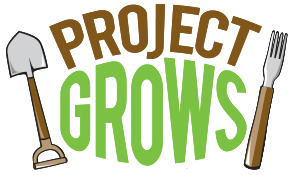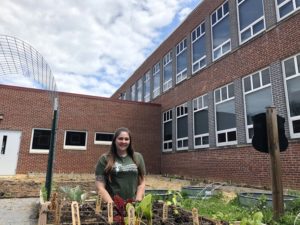
England Avis, Garden Coordinator at Bessie Weller Elementary
Resources/Recursos:
-
- Watch Episode 9/ Visualiza el Episodio 9
- Download Square Foot Gardening Planning Sheet/ Descarga las instrucciones de la actividad del Episodio 9 en Español
- Read this blog post in Spanish/ Lee esta entrada de blog en español
Welcome to Episode 9 of Signs of Spring, the FINAL episode in our spring video series! In this episode, Project GROWS has collaborated with England Avis, the Garden-Based Outdoor Learning Coordinator at Bessie Weller Elementary School, and Allegheny Mountain Institute to help you learn how to create your own square foot garden!
What will I learn in this episode?
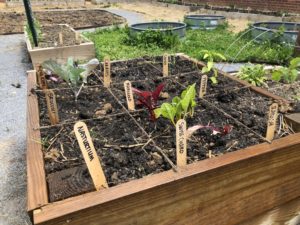
In the Signs of Spring series, we’ve learned a lot about the different types of plants growing at Project GROWS and in the Shenandoah Valley, as well as a few delicious recipes featuring some of our favorite vegetables. Now it’s time to create your own garden and start growing your own plants!
In this episode, England will walk you through the steps to create your own “square foot garden”. This type of garden is great for growing plants in smaller spaces and for keeping your garden neat and organized! First, England will show you how to design your square foot garden using a few common materials. Next, she will use the Project GROWS planting cards to help her decide what she wants to grow. In her square foot garden, England will be planting companion plants! These are special types of plants that help each other grow throughout the season when they are planted near one another. Finally, you will see two different ways to add new plants to your garden, transplanting and direct seeding, and learn some tips that will help you take care of your plants as they grow!
I’m ready to start! How do I lay out a square foot garden?
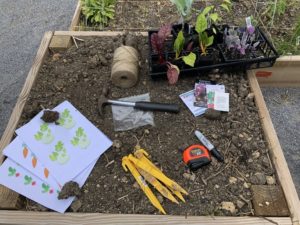
Materials needed to set up your square foot garden.
Before designing your new square foot garden, there are a few materials you will need:
- Stakes and twine – this will help to mark off the square foot areas
- Measuring tape and a marker
- Hammer and nails
- Plant starters
- Seeds
- The square foot planting cards from Project GROWS
To start, use the measuring tape and marker to mark off each square foot plot in your garden. If you are making an in-ground garden, use the stakes to mark off the corners of each square foot. A square foot can be measured by making a square in your garden that measures one foot on every side. On the outer corners of each square, hammer a nail about halfway in, then connect pairs of nails that are directly across the garden from each other using twine. In the end, you should have the twine spread across your garden in a grid pattern! With the square foot garden set up, now it’s time to add some plants!
How do I know WHAT to grow? And how should I PLANT my new plants?
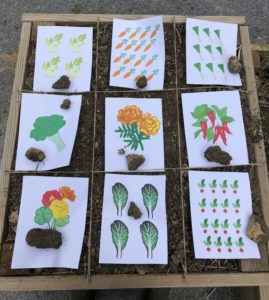 This is a great time to check out the Project GROWS planting cards and the square foot garden designer activity to plan out your garden before you plant. On the cards, you will see several different types of plants that will grow well in a square foot garden, as well as the number of plants you can grow in each square foot. The pepper plant, for example, is big and will need the whole square foot to grow. Carrots, on the other hand, do not need as much space, so you can add up to 16 in each square foot!
This is a great time to check out the Project GROWS planting cards and the square foot garden designer activity to plan out your garden before you plant. On the cards, you will see several different types of plants that will grow well in a square foot garden, as well as the number of plants you can grow in each square foot. The pepper plant, for example, is big and will need the whole square foot to grow. Carrots, on the other hand, do not need as much space, so you can add up to 16 in each square foot!
When you are ready to plant, you can either use Direct Seeding or Transplanting. If you have a packet of plant seeds, then you will want to try direct seeding Direct Seeding, in which you grow a brand new plant by placing the seeds directly in the soil. Check the back of the seed packet if you want some more information about growing your type of seed. If you already have a seedling that is growing, then you will want to Transplant your plant, which involves moving your plant from its home in one location to another home. To Transplant, grab the plant by the base of the stem near the soil and gently pull it out of its current home. Be sure to gently shake the roots out, and when you are ready, dig a hole in your square foot garden and place your plant into that hole. When the plant is safely in your garden, give it a little extra water to allow it to get situated in its new home!
What can I do to make sure my plants stay HEALTHY?
Plants are living creatures too! Because of this, they need plenty of water and sunlight in order to grow. Here are three things you should every day do to make sure your plants are staying happy and healthy:
- Water your plants
- Check for weeds – if you see any unfamiliar plants growing in your garden, pick them out!
- Make sure that your plants are receiving plenty of sunlight throughout the day
Within a few weeks, you should hopefully start to see your hard work paying off and your new plants sprouting!
Thanks for tuning in to our final Episode of Signs of Spring! Be sure to check out our other Signs of Spring videos linked on our blog and on our Youtube channel! Also, check out the Bessie Weller Elementary School Facebook Page to stay up-to-date on what is growing in England’s square foot garden!
